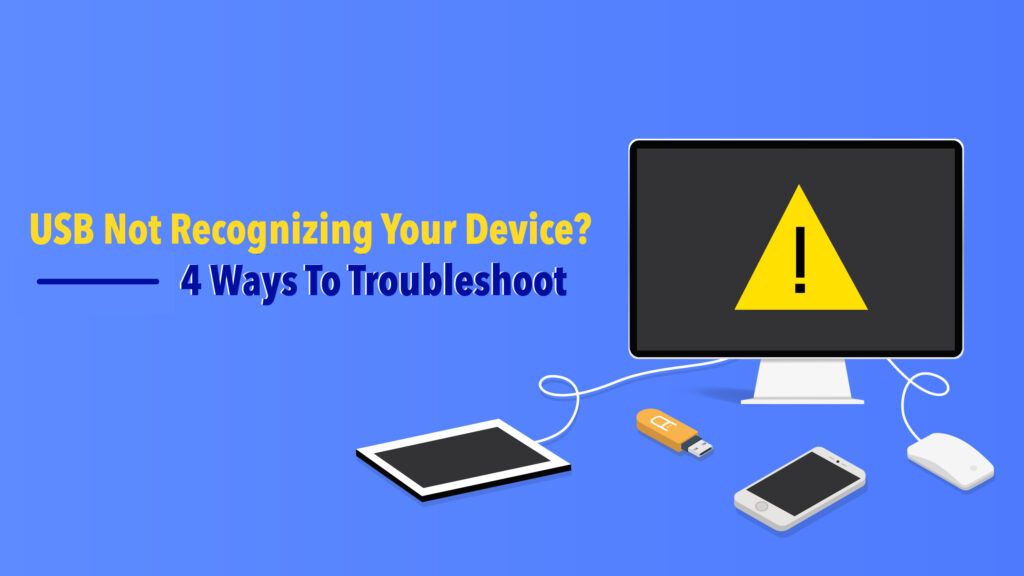Navigating the Disconnect: Understanding and Troubleshooting Device Not Recognizing USB Connections

Introduction:
In the era of digital connectivity, USB (Universal Serial Bus) connections serve as the backbone of device interaction, facilitating seamless data transfer, charging, and peripheral connectivity. However, amidst the convenience they offer, users often encounter the frustrating issue of devices not recognizing USB connections. Whether it’s a smartphone, tablet, computer, or peripheral device, this disconnect can disrupt workflows, hinder productivity, and compromise device functionality. In this comprehensive guide, we embark on a journey to unravel the complexities of devices not recognizing USB connections, exploring potential causes, effective troubleshooting strategies, and empowering users to overcome this common technological hurdle.
Understanding Devices Not Recognizing USB Connections:
The issue of devices not recognizing USB connections manifests when a device fails to detect or acknowledge the presence of a USB connection with another device or peripheral. This disconnect can occur for a myriad of reasons, ranging from hardware malfunctions and driver conflicts to software glitches and compatibility issues. Regardless of the underlying cause, resolving this issue requires a systematic approach, keen troubleshooting skills, and a thorough understanding of the interconnected systems at play.
Common Causes of Devices Not Recognizing USB Connections:
- Faulty USB Cable or Port: One of the most common culprits behind devices not recognizing USB connections is a faulty USB cable or port. Physical damage, wear and tear, or loose connections can impede the flow of data and prevent proper communication between devices.
- Outdated or Corrupt USB Drivers: USB drivers serve as the intermediary between the device’s operating system and connected USB peripherals. Outdated, corrupt, or incompatible USB drivers can hinder communication and prevent devices from recognizing USB connections.
- Software Glitches or Conflicts: Software bugs, glitches, or conflicts within the device’s operating system or driver software can disrupt USB communication and lead to devices not recognizing USB connections. These issues may arise due to incomplete software updates, conflicting drivers, or corrupt system files.
- Power Management Settings: Power management settings on the device or connected peripherals may affect USB functionality, causing devices not to recognize USB connections. Settings such as USB selective suspend or power-saving modes may interfere with USB communication and require adjustment.
- Peripheral Compatibility Issues: Compatibility issues between the device and connected USB peripherals, such as external drives, keyboards, or mice, can result in devices not recognizing USB connections. Differences in USB standards, protocols, or power requirements may prevent proper communication between devices.
- Operating System Updates: System updates or firmware upgrades may introduce unforeseen issues or conflicts that manifest as devices not recognizing USB connections. These issues are typically addressed in subsequent software patches or updates released by the device manufacturer.
Strategies for Troubleshooting Devices Not Recognizing USB Connections:
- Check Physical Connections: Begin troubleshooting by inspecting the USB cable, ports, and connected peripherals for signs of damage, wear and tear, or loose connections. Ensure that all connections are secure and properly seated to facilitate proper data transfer.
- Try Different USB Ports and Cables: If one USB port or cable appears to be faulty, try connecting the device to a different USB port or using a different USB cable to determine if the issue persists. This helps isolate the problem to a specific port or cable.
- Update USB Drivers: Ensure that the device’s USB drivers are up to date with the latest software updates and patches. Visit the device manufacturer’s website or use built-in driver update tools to download and install the latest USB drivers compatible with your device.
- Restart the Device: A simple restart of the device can often resolve temporary software glitches or conflicts causing devices not to recognize USB connections. Power off the device, wait a few seconds, then power it back on to refresh system processes and clear temporary caches.
- Disable Power Management Settings: Adjust power management settings on the device to prevent USB selective suspend or power-saving modes from interfering with USB communication. Disable or modify these settings to ensure uninterrupted USB connectivity.
- Perform System Updates: Ensure that the device’s operating system is up to date with the latest software updates and patches. Developers often release updates to address performance issues and introduce compatibility improvements, including USB connectivity issues.
- Test in Safe Mode: Boot the device in safe mode to disable all third-party apps and determine if the issue persists. If devices recognize USB connections in safe mode, a third-party app may be the culprit. Identify and uninstall recently installed or problematic apps to resolve the issue.
- Reset USB Settings: Reset USB settings on the device to their default configurations to eliminate any custom settings or configurations that may be causing USB connectivity issues. Consult the device’s user manual or online resources for instructions on resetting USB settings.
- Update Firmware: If the issue persists, consider updating the firmware of connected USB peripherals, such as external drives or keyboards. Manufacturers often release firmware updates to address compatibility issues and improve device functionality.
- Contact Customer Support: If all troubleshooting steps fail to resolve the issue, consider contacting the device manufacturer’s customer support for assistance. They may be able to provide additional guidance or recommend further troubleshooting steps to address the issue.
Conclusion:
Devices not recognizing USB connections present a significant inconvenience and frustration to users, disrupting workflows, hindering productivity, and compromising device functionality. However, armed with an understanding of common causes and effective troubleshooting strategies outlined in this guide, users can navigate this common technological hurdle with confidence and resilience. By adopting a systematic approach, keen troubleshooting skills, and a willingness to explore various solutions, users can overcome devices not recognizing USB connections and ensure uninterrupted data transfer and connectivity on their devices. So, don’t let USB connectivity issues derail your digital endeavors—take charge, troubleshoot effectively, and reclaim control over your device’s connectivity. With the right strategies and techniques, you can restore seamless USB communication and optimize your device’s functionality to suit your unique needs and preferences.




